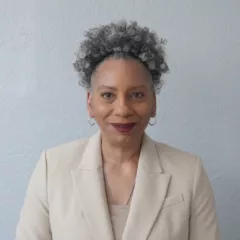Elizabeth follows up on a July 2022 Artblog piece by Tasso Hartzog that established Rocio and Renny meeting in the 1980s in the South Bronx, where Renny ran a gallery called Black and White in Color. They moved from New York to Philly in 2002 and started iMPeRFeCT Gallery in 2012, about a block away from where it is now. In a 2013 Artblog podcast, Libby and Roberta learned that the couple left New York for Philadelphia because it is so much cheaper, and they love the green spaces and buildings of Germantown.
Elizabeth Johnson: You have been in Philadelphia in the Germantown area for twenty years. You mentioned in the Artblog podcast that when you were in New York City, Richard Serra and other VIPs came to your gallery, and it felt like success and money were starting to come to you. Have your thoughts about running a gallery and how it intersects with success and money changed?
Renny Molenaar: At that time in New York, I was overwhelmed. The Andy Warhol Foundation had given us a grant. Artists started to look to us for career guidance, and I didn’t want to be a gallerist who represented artists. We are still clear about our goals. We would like to get funding from someone who is interested in the work we do already. iMPeRFeCT Gallery supports art that is passionate, dynamic and fresh–where art meets politics on the streets.
We also want to keep our freedom to pursue our own personal work. I’ve cut back on teaching. When I was teaching art, I wanted every kid to succeed, but other teachers told me that if even one improves it is a success. The students kept needing support that I couldn’t sustain. It was the same for Rocio, she got crazy busy working in a family Graphics Art business with her sister, and then they both gave it up.
Rocio Cabello: My sister is a yoga teacher now, so much happier, and so am I. The work I’m doing with the gallery is much more fulfilling, even as it takes so much time from my personal art-making time. It’s a fine line to walk, because more success also brings expectations and pressure.
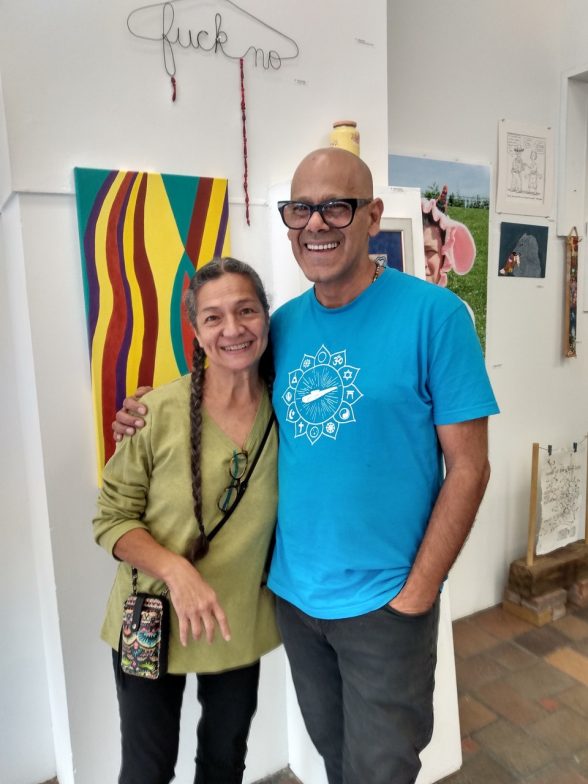
EJ: Besides a great location, more time to do your own work, and less art world pressure–What else sets being an artist in Philadelphia apart from being one in NYC?
RM: Art is more dynamic in New York and art appreciation is more natural. People think art is for the rich, and they lack awareness of art and art education, that is one reason we take art out onto the street and into the community. For example. I made an installation of books in a pile that ended up being about censorship. I covered the books in fabric and stitched them up so you couldn’t open them. (I was covering lots of stuff in fabric at the time: a police car, mufflers, votive candles.) People saw the pile and said, “oh good and that’s nice.” Only one guy–he was poorly dressed, he might have been homeless–he got it. He said, “are you burning books?” He made the connection, and it made me so happy, but I’m aware that many people wouldn’t.
EJ: In the July 2022 Artblog piece, Tasso describes weekly rumbas as “organic gatherings of percussionists and enthusiasts of different backgrounds and nationalities, all united by their love of this Cuban call and respond tradition, the rumbas are not performances,” Are you still holding rumbas? What other regular events do you hold that invite the community into the gallery?
RC: We had a rumba last night. We hold them dear to our hearts, as they are very significant gatherings culturally but they don’t really earn money. We need to look for funding to keep them going in a more sustainable way.
RM: I was in here mopping up afterwards.
RC: We also invite the community for “last suppers,” dinners after every art show.
We have artist talks, and curate solo performances. We cross pollinate artists, poets and musicians.
EJ: In the Roberta and Libby podcast you talk about the social and political aspects of the gallery. Is that still your central focus?
RM: We are Hispanic immigrants, art is going to be political for us on all levels, it is interwoven with our nature. We treat the gallery as a socio-cultural-political space. Whether you are rich or poor, you deserve art. I want to bring the priesthood of high culture to regular people. But we don’t live there all the time. We also love artists who show other types of work.
Our 10th Annual Germantown Show was called “Hands Off– Women’s Bodies, Women’s Rights.” We exhibited 84 artists in solidarity with the abortion rights. I installed the work, and I’m always surprised by how adjacent pieces talk to each other. We had well-know people next to teens, people of all different levels.
My work is the black flag that has barrettes that form a coat hanger. I work with color and story through repetition. I am a compulsive accumulator.
A former street installation of mine grouped sculptures made of single barrettes mounted on single wires, I was basically putting barrettes on pedestals. The pieces referred to child abuse in young girls: the little flowers being taken. A little girl and her mom walked by the street installation, I saw them talking at the corner, and they came back and asked if they could ask a question. I said, “That’s why I’m here.” The little girl asked why I made such sad art. I was so moved that the idea came across to her even though she was so young.
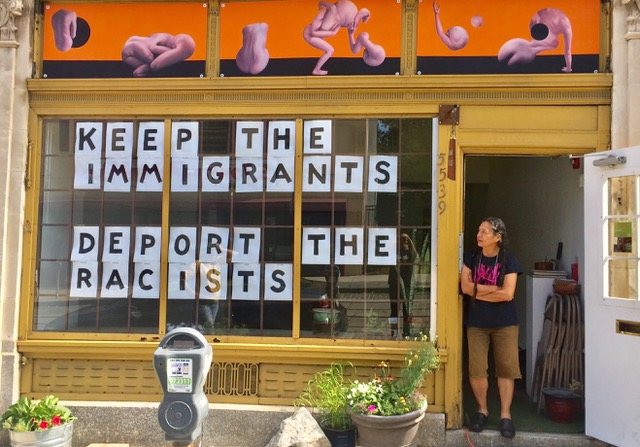
RC: The gallery has been a tool to bring about social change in our neighborhood; our mission is to create a space for creatives to meet, work, network, and inspire each other, and also show our neighbors what artists and art in general can mean in their lives and I think we’ve done that. We have also created opportunities to voice the political concerns that affect us and the public at large.
Renny has been working with barrettes since we came to Philadelphia.
He and I did a similar pattern for “Hands Off” without knowing what the other was doing. I made a hanger sculpture out of wire that says, “Fuck You.” I bent wire to spell the words and mimic a real hanger that is strung with red beads.
RM: I’ve always worked with stuff I find on the street. I like to work with objects that people have used, that tell their story or carry their presence. I used to walk around New York and pick up what I called collectibles: crack vials, lighters, clothes, tires, car hoods, and steering wheels, all things that I made art out of. I am an urban anthropologist.
RC: We still have lots of these pieces. There is a car hood upstairs.
RM: Back then I was inspired by the poetry of Langston Hughes and the poet and playwright Miguel Piñero, who wrote the award-winning play Short Eyes. Micky was our friend, he was known as the “Junkie Christ.” (Not many people know that he was an authority on Film Noir.) We hung out at the Nuyorican Poets Cafe. Bob Holman who was married to Elizabeth Murray ran the cafe for a while. Joseph Papp of the Public Theater, Miles Davis, and Alvin Ailey were around then. I was making lots of dark photographs on slow film.
EJ: You mention that you had kids, are they involved in their own lives or careers? Are they interested in the gallery? Are they artists?
RC: Both our boys grew up in the gallery and excel at computers and math. Our youngest, Cory is interested in music and just joined a percussion group. Giza is in college studying engineering.
EJ: How does the gallery make money now?
RC: I run the administrative aspects of our non-profit gallery, that operates under a Philadelphia umbrella organization: Renny curates and hangs the shows. Right now, we make money mostly through donations during events, group shows participation fees, sales of artwork, our End of Year online campaigns and some local government grants. We are also renting another flexible, open space next door to musicians, dancers and actors that need rehearsal space or guest curators from other galleries. A dancer who needed space to practice recently, on short notice, was able to work with us.
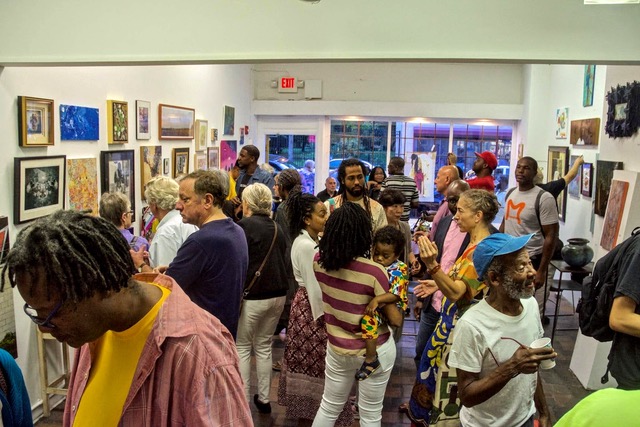
EJ: How about in 2021?
RM: We opened and then had to close during 2021. A theater friend helped me build seven-foot-high prism-shaped pillars to exhibit artwork in the streets when we couldn’t open the gallery. It was a lot of work moving the pillars around, and we had to source vehicles, but the show made a big impact and got art out on the sidewalks.
RC: During COVID people left us food, and we would visit food banks and share information about free stuff. There’s these two guys Tom and Ted who collect expired food from grocery stores and distribute it, we have met good people in this community.
EJ: Coming in I walked by a new condo project. Is there gentrification happening here?
RM: Rent and sales prices are on the rise, but we are not at the displacement stage yet, there are so many places to fix up. Investors are buying and building, some of them are fostering ground floor businesses with free build-out and rent. The Germantown Espresso Bar, where we love to go, got a new space this way. That painting on the wall by Karl Blau depicts the former coffee shop building.
RC: People that live here are starting to get worried, there are meetings about gentrification already.
RM: We want a hardware store, a family restaurant, better produce, an ice cream shop, and better services. We want development, but we don’t want gentrification.
EJ: Rocio, you mentioned in the podcast that while living in a squat and working on a community garden in the Bronx, the smell of dirt connected you with childhood memories of Peru. You speak of this as a turning point, a moment that you started to build on your art background.
RC: Yes, working the wet soil one day after a rain triggered strong memories. I remembered having smelled and done that before. My parents, especially my dad, was really into growing our own food in our garden. My dad used to come home for lunch, change his clothes, and go right out to work in the garden. I share that with him, a passion for growing food. It remembered how important and how meditative it was and that allowed me to understand him better, and as a consequence to understand myself. I decided to educate myself and garden as a way to affect my surroundings, which in those days was very grim, if you picture the Bronx in the late 80’s. It helped me discover a renewed purpose, where I could make a difference in my life and in the life of others.
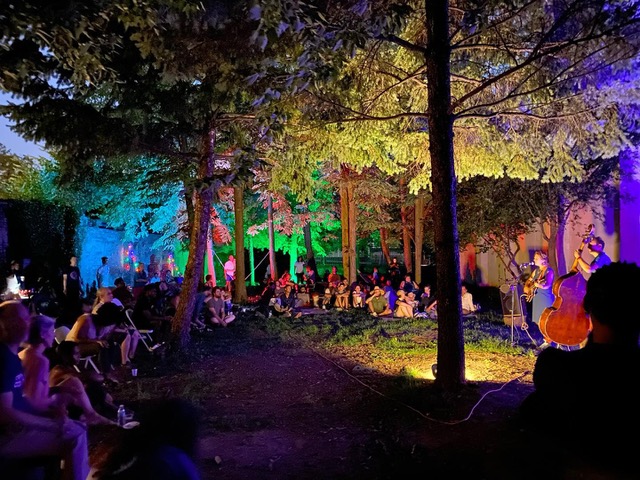
EJ: Can you give an example of how the past or gardening affects your work today? What are you thinking about or working on now for the gallery?
RC: The insights I gained by working with plants helped me understand my place in the world, while also helping me heal from past traumas. I continue to incorporate gardening in my work to share my experience with others, hoping it will do the same for them. As I continue to engage the public through the gallery, I’m finding ways to invite them to a green space I’m working on now, right across the street. I use the fence of that space to leave messages of hope, or calls for introspection and action to my neighbors, and also welcome them to enjoy the events we hold in the garden so they can feel the calm and power of surrounding yourself in nature.
We’ve also started using the gallery’s front window as a message board. During Covid, we wrote the Bob Marley quote “Every Little Thing, Gonna Be Alright”, when we sensed the building anxiety of facing the new and unknown reality.
EJ: We talked about getting help writing grants to fund the service that you are providing as working artists being positive forces in the community. If an investor gave you 5 million dollars to use for community purposes, how would you structure investing and spending it?
RC: We totally would extend the space we have now. I would love to build a public garden for art and supporting mental health. I would look for a building with an outdoor space and sculpture garden that is community and child friendly.
RM: I’d like to hire a director to help us manage staff, spending, art fairs.
It would be great to have people in charge of different jobs since we do everything.
I also have the dream of getting into printmaking and publishing.
EJ: The gallery mission on the press release states that iMPeRFeCT Gallery aims “To Give Art a Voice,” “To Facilitate,” and “To Engage in the Conversation.” How do you find artists? Or do they find you?
RM: Anybody can come and show me work and no matter who they are, if the work is good, I’m going to want to show them. I look for commitment and passion. I even will show work I don’t like if it is good. Nobody gets a pass. I am interested in how we are going to get through the non-relationship created by race and class. It’s part of the reason that I’m interested in work about the street and sex, everything is transactional. In general, the art world is slow to grow and produce, but art stays. Recently, we were one of the thirty organizations nominated for a William Penn Foundation, Philadelphia’s Cultural Treasures award. We weren’t one of the twelve that received this year, but were honored to be nominated and hope to stay on the radar.




